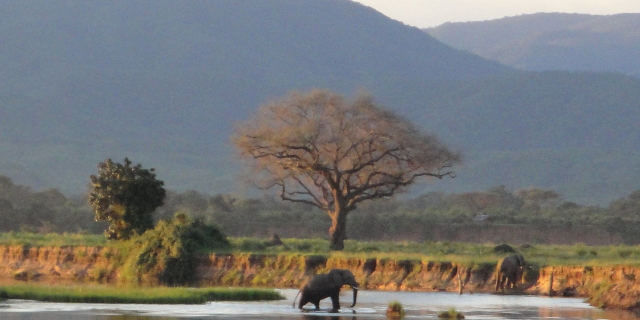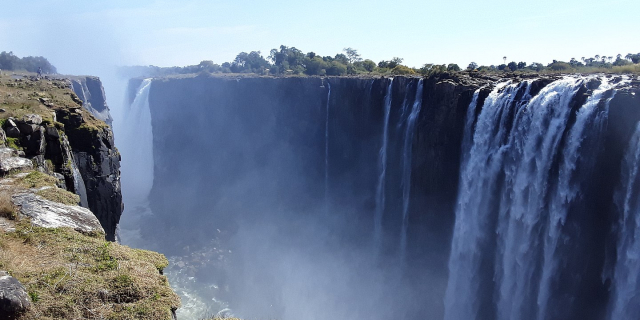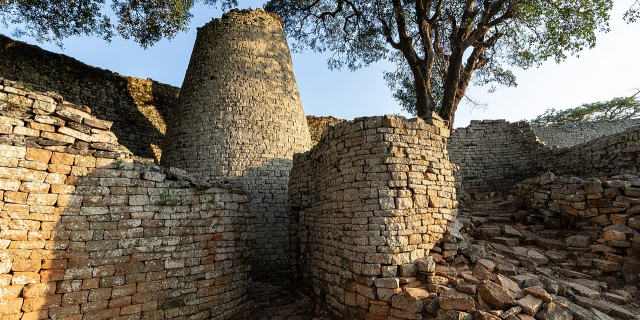Victoria Falls (Lozi: Mosi-oa-Tunya, "Thundering Smoke"; Tonga: Shungu Namutitima, "Boiling Water") is a waterfall on the Zambezi River in southern Africa, which provides habitat for several unique species of plants and animals. It is located on the border between Zambia and Zimbabwe and is one of the world's largest waterfalls, with a width of 1,708 m (5,604 ft).
Archeological sites and oral history describe a long record of African knowledge of the site. Though known to some European geographers before the 19th century, Scottish missionary David Livingstone identified the falls in 1855, providing the British colonial name of Victoria Falls after Queen Victoria. Since the mid 20th century, the site has been an increasingly important source of tourism. Zambia and Zimbabwe both have national parks and tourism infrastructure at the site. Resear...Read more
Victoria Falls (Lozi: Mosi-oa-Tunya, "Thundering Smoke"; Tonga: Shungu Namutitima, "Boiling Water") is a waterfall on the Zambezi River in southern Africa, which provides habitat for several unique species of plants and animals. It is located on the border between Zambia and Zimbabwe and is one of the world's largest waterfalls, with a width of 1,708 m (5,604 ft).
Archeological sites and oral history describe a long record of African knowledge of the site. Though known to some European geographers before the 19th century, Scottish missionary David Livingstone identified the falls in 1855, providing the British colonial name of Victoria Falls after Queen Victoria. Since the mid 20th century, the site has been an increasingly important source of tourism. Zambia and Zimbabwe both have national parks and tourism infrastructure at the site. Research in the late 2010s found that precipitation variability due to climate change is likely to change the character of the fall.
 Satellite image showing the broad Zambezi falling into the narrow cleft and subsequent series of zigzagging gorges (top of picture is north).Geological history
Satellite image showing the broad Zambezi falling into the narrow cleft and subsequent series of zigzagging gorges (top of picture is north).Geological history
The basalt plateau of Victoria Falls, over which the Zambezi River flows, was formed during the Jurassic period, around 200 million years ago.
Pre-colonial historyEarly Stone Age Acheulean stone artefacts and Oldowan tools were excavated at archaeological sites around the falls, as well as Sangoan tools and Lupemban artefacts dating to the Middle Stone Age.[1]Early Iron Age pottery was excavated at a vlei site near Masuma Dam in the early 1960s.[2] Evidence for iron smelting was also found in a settlement dated to the late first millennium AD.[3]
The southern Tonga people known as the Batoka/Tokalea called the falls Shungu na mutitima. The Matabele, later arrivals, named them aManz' aThunqayo, and the Batswana and Makololo (whose language is used by the Lozi people) call them Mosi-o-Tunya. All these names mean essentially "the smoke that thunders".[4]
A map drawn by Nicolas de Fer in 1715 shows the fall clearly marked in the correct position. It also shows dotted lines denoting trade routes that David Livingstone followed 140 years later.[5] A map from c. 1750 drawn by Jacques Nicolas Bellin for Abbé Antoine François Prevost d'Exiles marks the falls as "cataractes" and notes a settlement to the north of the Zambezi as being friendly with the Portuguese at the time.[6]
19th centuryIn November 1855, David Livingstone was the first European who saw the falls, when he travelled from the upper Zambezi to the mouth of the river between 1852 and 1856. The falls were well known to local tribes, and Voortrekker hunters may have known of them, as may the Arabs under a name equivalent to "the end of the world". Europeans were sceptical of their reports, perhaps thinking that the lack of mountains and valleys on the plateau made a large falls unlikely.[7][8]
Livingstone had been told about the falls before he reached them from upriver and was paddled across to a small island that now bears the name Livingstone Island in Zambia. Livingstone had previously been impressed by the Ngonye Falls further upstream, but found the new falls much more impressive, and gave them their English name in honour of Queen Victoria. He wrote of the falls, "No one can imagine the beauty of the view from anything witnessed in England. It had never been seen before by European eyes; but scenes so lovely must have been gazed upon by angels in their flight."[9]
In 1860, Livingstone returned to the area and made a detailed study of the falls with John Kirk. Other early European visitors included Portuguese explorer Serpa Pinto, Czech explorer Emil Holub, who made the first detailed plan of the falls and its surroundings in 1875 (published in 1880),[10] and British artist Thomas Baines, who executed some of the earliest paintings of the falls. Until the area was opened up by the building of the railway in 1905, though, the falls were seldom visited by other Europeans. Some writers believe that the Portuguese priest Gonçalo da Silveira was the first European to catch sight of the falls back in the sixteenth century.[11][12]
History since 1900 Victoria Falls' Second Gorge (with bridge) and Third Gorge (right). The peninsular cliffs are in Zambia, the outer cliffs in Zimbabwe. The cliffs are composed of Batoka Formation basalt flows. The breaks in slope with vegetation are brecciated amygdaloidal basalt zones separating six successive and massive lava flows with distinct vertical jointing.[13][14]: 391 Victoria Falls Bridge initiates tourism
Victoria Falls' Second Gorge (with bridge) and Third Gorge (right). The peninsular cliffs are in Zambia, the outer cliffs in Zimbabwe. The cliffs are composed of Batoka Formation basalt flows. The breaks in slope with vegetation are brecciated amygdaloidal basalt zones separating six successive and massive lava flows with distinct vertical jointing.[13][14]: 391 Victoria Falls Bridge initiates tourism
European settlement of the Victoria Falls area started around 1900 in response to the desire of Cecil Rhodes' British South Africa Company for mineral rights and imperial rule north of the Zambezi, and the exploitation of other natural resources such as timber forests north-east of the falls, and ivory and animal skins. Before 1905, the river was crossed above the falls at the Old Drift, by dugout canoe or a barge towed across with a steel cable.[15] Rhodes' vision of a Cape-Cairo railway drove plans for the first bridge across the Zambezi. He insisted it be built where the spray from the falls would fall on passing trains, so the site at the Second Gorge was chosen. (See the main article Victoria Falls Bridge for details.[9]) From 1905 the railway offered accessible travel from as far as the Cape in the south and from 1909, as far as the Belgian Congo in the north. In 1904 the Victoria Falls Hotel was opened to accommodate visitors arriving on the new railway. The falls became an increasingly popular attraction during British colonial rule of Northern Rhodesia (Zambia) and Southern Rhodesia (Zimbabwe), with the town of Victoria Falls becoming the main tourist centre.
During independence movementsIn 1964, Northern Rhodesia became the independent state of Zambia. The following year, Rhodesia unilaterally declared independence. This was not recognised by Zambia, the United Kingdom nor the vast majority of states and led to United Nations-mandated sanctions. In response to the emerging crisis, in 1966 Zambia restricted or stopped border crossings. It did not re-open the border completely until 1980. The Rhodesian Bush War erupted on the southern side of the Zambezi from 1972 to 1980 with terrorist incursions from Zambia, Mozambique and Botswana. Visitor numbers began to drop, particularly on the Rhodesian side. Periodic Rhodesian military cross border operations against guerrilla camps in Zambia, causing the Zambians to impose security measures including the stationing of soldiers to restrict access to the gorges and some parts of the falls.
Zimbabwe's internationally recognized independence in 1980 brought comparative peace, and the 1980s witnessed renewed levels of tourism and the development of the region as a centre for adventure sports. Activities that gained popularity in the area include whitewater rafting in the gorges, bungee jumping from the bridge, game fishing, horse riding, kayaking, e-biking, and sightseeing flights over the falls.[16]
Tourism in recent years The naturally formed "Devil's Pool", where tourists swim despite a risk of plunging over the edge
The naturally formed "Devil's Pool", where tourists swim despite a risk of plunging over the edgeBy the end of the 1990s almost 400,000 people were visiting the falls annually, and this was expected to rise to over a million in the next decade. Unlike the game parks, Victoria Falls has more Zimbabwean and Zambian visitors than international tourists; the attraction is accessible by bus and train, and is therefore comparatively inexpensive to reach.
Both countries permit tourists to make day trips across the border to view the falls from both viewpoints. Visitors with single-entry visas are required to purchase a visa each time they cross the border; visas can be obtained at both border posts. Costs vary from US$50–$80 (as of January 2017[update]). Visa regulations change frequently; visitors are advised to check the rules currently in effect in both countries before crossing the border in either direction. Additionally, foreign tourists may purchase a KAZA visa for US$50 that will permit visitors to travel between Zambia and Zimbabwe for up to 30 days as long as they remain within the covered countries.
A famous feature is the naturally formed "Armchair" (now sometimes called "Devil's Pool"), near the edge of the falls on the Zambian side, along the western tip of Livingstone Island. When the river flow is at a certain level, usually between September and December, a rock barrier forms an eddy with minimal current, allowing adventurous swimmers to splash around in relative safety in front of the point where the water cascades over the falls.[17] One death of a tourist guide has been reported.[18]
The numbers of visitors to the Zimbabwean side of the falls has historically been much higher than the number visiting the Zambian side, due to the greater development of the visitor facilities there. However, the number of tourists visiting Zimbabwe began to decline in the early 2000s as political tensions between supporters and opponents of president Robert Mugabe increased. In 2006, hotel occupancy on the Zimbabwean side hovered at around 30%, while the Zambian side was near capacity, with rates in top hotels reaching US$630 per night.[19][20] The rapid development has prompted the United Nations to consider revoking the falls' status as a World Heritage Site.[21] In addition, problems of waste disposal and a lack of effective management of the falls' environment are a concern.[22]


























Add new comment